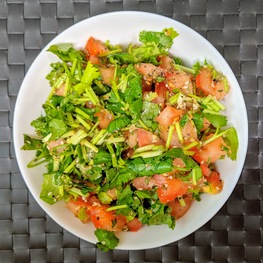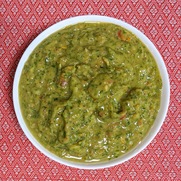The final preparation is delectable! What makes it so? Let's see.
- Select a good combination of veggies! Explained in detail below.
- Roast veggies in their whole form or 'chop & steam'. Why whole for roasting but chopped for steaming? Explained in detail below.
- (Optional) Add some frozen veggies: I use frozen sweet corn, frozen sweet peas, frozen edamame and frozen rhubarb. All of these are available near my home.
- Prepare a "dressing": I use a combination of tomato, lemon, herbs (mint, cilantro, …), dried herbs & spice mixes. I also include dried berries that have been soaked for a few minutes. Many other dressings are possible. Explained below.
- Mix the dressing with frozen, roasted / steamed veggies: Roasted veggies should be diced into smaller pieces before mixing.
- Click pics n serve!
Generally speaking, I use a combination of veggies from all of the classes listed below.
(1) Tubers: Potatoes and Sweet Potatoes are superfoods! According to Dr Greger, sweet potatoes are best, especially colorful sweet potatoes! I have visited multiple shops near my home looking for colorful sweet potatoes. I found them in Whole Foods, Costco and Hancook Supermarket.
(2) Cruciferous: List of cruciferous veggies. I use Brussel sprouts, purple cabbage, purple cauliflower and turnip. Dr Greger explains how to consume cruciferous veggies so that we actually produce sulforaphane -- a compound with magical properties -- when we consume cruciferous. See these articles: Broccoli Sprouts and Daily Cruciferous Intake: How To?
(3) Allium: Red onion, sweet onion.
(4) Juicy, Colorful Veggie: Bell peppers, sweet peppers, opo squash, zucchini, chayote, butternut squash, kambocha squash, …
(5) Misc Root Veggies: Carrots, parsnips, beet!
(6, optional) Mushrooms: many varieties. I use the commonest mushrooms: button mushrooms.
(7, Optional) Corn or Plantains: Both of these are awesome additions!
Which veggies are missing? This recipe has no leafy greens. My leafy green intake comes via Salads and Beans n Greens preparations.
Combinations: Do I always pick veggies from every group for every meal? Not really. But I always pick tubers (colorful sweet potatoes, especially purple sweet potatoes) and colorful & juicy veggies.
Ratios? In what ratio do I pick tubers, cruciferous, allium and juicy colorful veggies? My approach is to consume as many tubers as we feel like. Why? What Are Tubers? Are They Healthy? explains why tubers are underappreciated superfoods! In fact, the Okinawans (among the longest living people) were deriving upwards of 65% of their calories from just one specific food: purple sweet potatoes! Next come juicy colorful veggies: I'd consume them in abundance. Alliums and cruciferous veggies: I'd be comfortable consuming them in quantities less than those shown in pics above.
ROASTING
Devices: For roasting, I invested in a Breville Smart Oven Air, inspired by Breville Smart Oven Air Recipes by Tami from Nutmeg Notebook. I also invested in Silpat Premium Non-Stick Silicone Baking Mat.
Whole vs chopped? I always roast veggies in their whole form. This way, they retain their juiciness after roasting. For large-sized veggies like butternut squash, I carve out one large piece and roast it whole. After roasting, veggies become soft — that's when I chop them.
Temperature for roasting? 400F.
How long to roast? Some veggies like sweet peppers, small-sized onions, mushrooms and asparagus need only 15 minutes at 400F. Some others need 30 mins. Large sized potatoes may need 45 mins.
STEAMING
Devices: For steaming, I invested in Cuisinart Steamer. Several electric steamers are found on Amazon. I don't have personal experience with them.
Whole vs Chopped: When I steam veggies, I chop them into smaller pieces before steaming.
How long to steam? Until the veggie has become tender enough that a knife will easily pass through. Some people like their veggies crunchier, in which case we can stop steaming earlier. Do not oversteam! Oversteaming will make veggies 'mushy' and bland.
Water: I reuse the water in the bottom pot of a steamer for preparing grains and beans. Many times, I do these processes in parallel: the bottom pot of a steamer is used for boiling grains or beans or both mixed together; the top part of the steamer is used for steaming veggies.
Healthy Girls' Kitchen has two "Big Lists of No Oil Salad Dressings": Part I and Part II! These lists include dressings by various Whole Flood Plant-Based doctors and chefs.
I like 5 Dressings by Fully Raw Kristina (8 mins) awesome! They don't use tamari, liquid aminos, soy sauce, etc. Basically, Fully Raw Kristina simply grinds a subset of salad ingredients together and pours the paste onto the salad :)
What kind of dressings do I like? I like non-blended dressings made from fresh herbs, tomatoes and spices. And I'm comfortable with chunky pieces of herbs like cilantro, including their stems. Here are some examples:
LEMON-PEPPER DRESSING: This is the simplest of dressings that suffices for me when I have no time to prepare a dressing. It has 2 ingredients:
- Citrus: Lemon (or vinegar if fresh lemon is unavailable).
- Herbs & Spice Mix: I often use a spice mixture (which has dried herbs n spices). Herbs de Provence is great! But there's one spice that it sufficient by itself: black pepper. Lemon n black pepper is a great minimalist combo for enhancing the taste of roasted / steamed veggies.
- Nuts n seeds: I add a few sunflower seeds or pumpkin seeds. Why? In this video, Dr Greger explains that fats boost the absorption of micronutrients from veggies.
CILANTRO-TOMATO DRESSING: This dressing has tomatoes, fresh herbs, spices and avocado (optional).
- Citrus: Lemon or Vinegar
- Veggies: Finely chopped tomatoes.
- Herbs: Fresh Cilantro (or Parsley or Mint or whatever is available in the market) or dried herbs like Herbs de Provence.
- Spices: Lemon-Pepper mix or whatever spice you like.
- Nuts n seeds (or avocado): I add a few sunflower seeds or pumpkin seeds. In this video, Dr Greger explains that fats boost the absorption of micronutrients from veggies.
- (Optional) Soaked berries: Dried berries soaked in water is a great addition from both nutrition and taste perspective! I have 5 dried berries at home: cranberries, goji berries, golden raisins, white mulberries, barberries. To appreciate the nutritional benefits of berries, please see these two articles: Berries and Antioxidants.
FRUITY DRESSING: This dressing has fruits, herbs n spices! :)
- Citrus: Orange or lemon (if neither is available, use vinegar).
- Berries: Dried berries soaked in water. I have 5 dried berries at home: cranberries, goji berries, golden raisins, white mulberries, barberries. To appreciate the nutritional benefits of berries, please see these two articles: Berries and Antioxidants.
- Nuts n seeds (or avocado): I add a few sunflower seeds or pumpkin seeds. In this video, Dr Greger explains that fats boost the absorption of micronutrients from veggies.
- Herbs: Individual dried herbs like {oregano, thyme, basil, mint, &hellip} or a mixture like Herbs de Provence.
- Spices: Lemon-pepper mix or whatever spice you like.
Sometimes, I introduce (a) frozen sweet corn, (b) frozen edamame, (c) frozen green peas, and (d) frozen rhubarb into the recipe. These add both color and nutrition! With these additional ingredients, we now have grains (sweet corn) and soy foods (edamame) as well! Overall, this increases the diversity of food groups that we get to consume in a single meal!
Food Groups: If we include all of the ingredients listed above, we cover so many food groups: grains (sweet corn), soy foods (edamame), tubers (colorful sweet potatoes), cruciferous (brussel sprouts, …), alliums (sweet onion), colorful juicy veggies (bell pepper, …), root veggies (carrots, parsnips, beet, …), mushrooms, berries, herbs n spices!
Rainbow Colors: The final recipe is not only bursting with flavor and but has rainbow colors as well!
Easy to Prepare: All we do is this: (a) Place whole veggies in a smart oven and start roasting, (b) Prepare a "dressing", (c) Clean some frozen veggies in a dish, (d) After roasting, chop roasted veggies into smaller pieces, (e) Mix everything together, (f) Clean the Silpat liner used for roasting, (g) Enjoy the preparation!
G-BOMBS is an acronym for Greens, Beans (Legumes), Onions, Mushrooms, Berries and Seeds. In the recipe above, if we have included frozen edamame beans, onions, mushrooms, berries and seeds, we got BOMBS but we're missing G (Greens). Maybe we can introduce some chopped kale or chopped collards into the mix to have all 6 components of G-BOMBS :-)

 Instagram
Instagram YouTube
YouTube






























